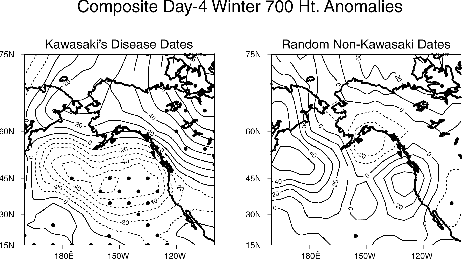6.5 Public Health and Climate Research
During the last decade, there has been considerable interest in better understanding the possible impacts of climate variability on public health. This interest has evolved into a basic research component within the CDC experimental climate services portfolio. These interdisciplinary research activities not only provide a better understanding of the relationships between climate variability and human health, but also guide climate research to ensure the development of the climate information needed to better forecast or monitor potential public health crises.
6.5.1 Precipitation and encephalitis
CDC is currently collaborating with epidemiologists at the University of California at Davis and the Scripps Institution of Oceanography on possible associations between interannual precipitation changes and variations in the incidence of western equine encephalitis (WEE) in the Central Valley of California. WEE and SLE (St. Louis encephalitis) are mosquito-borne diseases endemic in California. Human vaccines and therapeutic drugs currently are not available for the viruses, and vector abatement remains the only method of controlling human infection. Vector abatement relies strongly upon accurate surveillance of environmental conditions to provide sufficient warning to implement intervention. Amplification of encephalitis viruses to levels that place the human population at eminent risk of infection depends on the rate of virus replication in the mosquito host. The replication rates are related to temperature and mosquito population size which in turn are related to surface water availability. Improved understanding of global (and tropical Pacific) atmospheric teleconnections, the use of numerical model guidance for long range forecasting of climatic conditions in California, and the availability of short-range forecasts in conjunction with hydrological models, can collectively provide accurate depictions of snowpack and run-off. Quantitative relationships between climate and enzootic virus amplification are being developed retrospectively to forecast the level of virus activity during the principal transmission seasons of spring and summer.
6.5.2 Climate variability and Kawaski disease
A second collaborative research project with the University of California at San Diego and Scripps is to improve current understanding of the possible link between weather and climate variability and Kawasaki Disease (KD), an acute illness of the circulatory system primarily affecting infants and young children. A winter and spring seasonal KD peak has been recognized for over two decades, but recent studies suggest an association at synoptic time scales as well. KD incidence data for San Diego County from 1994 to present shows a moderate correlation with precipitation. The distribution of cases is characterized by the presence of clusters in which multiple KD cases occurred within a time interval of just a few days. Fifteen clusters occurred during the cool season (November-April) between 1994 and 2000. Weather patterns were examined starting 6 days before and continuing through 6 days after the date of KD onset (first day of fever is designated day 0) for the first child in the cluster. The composite patterns were compared to a second control sample of randomly selected days for the same cool seasons (1994-2000), but during prolonged periods with no KD events. The 700mb height anomaly field was composited over the 15-event sample set. The atmospheric circulation pattern preceding the occurrence of KD data clusters exhibit strong negative anomalies over the North Pacific upstream from San Diego (Fig. 6.12, left panel), indicating an active storm track and typically wet conditions in San Diego County. This pattern appeared to be developing by Day -6, was very strong on Day -4, and then persisted, though weaker, for several days thereafter. In contrast, the composite from control sample days extracted from the non-KD periods shows no significant anomaly pattern in atmospheric circulation over the Pacific (Fig. 6.12, right panel). Inspection of the 15 individual KD clusters revealed precipitation of at least 0.1" associated with 10 of the clusters. These results warrant further investigation and exploration of other variables (humidity, cloud cover, minimum temperature, time elapsed since last significant rain storm) in relation to KD clustering.

CDC scientists are also part of an international regional network to foster interdisciplinary research to better understand the relationships between climate variability and human health in the Americas. As part of a five-year project funded by the InterAmerican Institute for Global Change Research, a major effort is underway to develop a database of climate and selected human diseases, primarily vector borne diseases, such as malaria and dengue fever, to allow diagnostic studies and monitoring activities to be carried out.